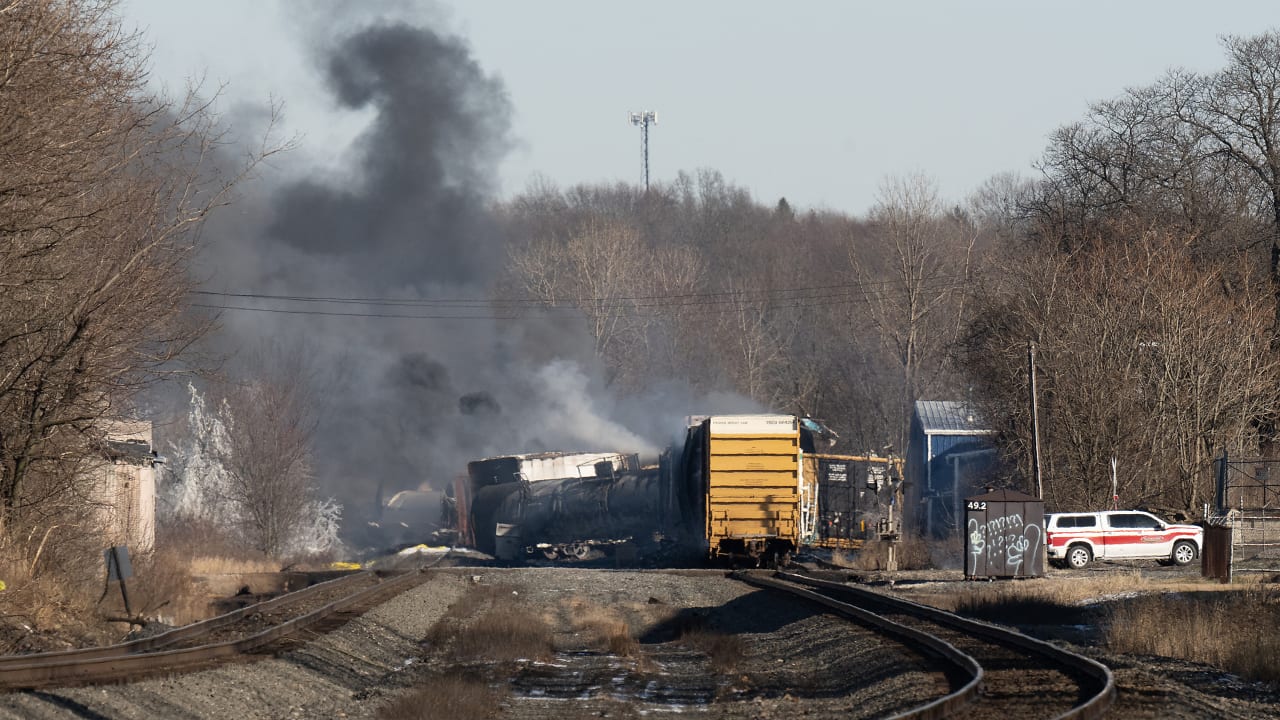Ohio Train Derailment: Months Of Lingering Toxic Chemical Contamination In Buildings

Table of Contents
Extent of the Contamination
Initial Spill and Subsequent Spread
The initial derailment released a cocktail of hazardous chemicals, including vinyl chloride, butyl acrylate, and ethylene glycol monobutyl ether. These chemicals are known to have various acute and chronic health effects, ranging from skin irritation and respiratory problems to potential long-term carcinogenic effects. The immediate impact was catastrophic, but the concern now centers on the lingering contamination. The initial explosion and subsequent controlled burn released plumes of toxic smoke, and the chemicals didn't remain confined to the immediate derailment site. Evidence suggests that contaminants spread beyond the immediate area through:
- Airborne Dispersion: Toxic fumes traveled significant distances, potentially depositing chemicals on surfaces within buildings.
- Water Runoff: Rainfall and snowmelt carried chemicals into the soil and water systems, potentially contaminating basements and groundwater.
- Soil Contamination: The soil surrounding the derailment site is heavily contaminated, posing a risk of leaching into building foundations.
Specific buildings near the derailment site, including some residential homes and potentially businesses, have been identified as having elevated levels of contamination, although the full extent is still being assessed. Limited data released from initial testing revealed high concentrations of specific volatile organic compounds (VOCs) within certain structures. However, further comprehensive testing and data release are needed to fully understand the extent of the problem.
Testing and Remediation Efforts
The assessment of building contamination relies on several methods, including:
- Air Quality Testing: Measuring VOC levels inside buildings to detect the presence of harmful chemicals.
- Soil Sampling: Analyzing soil samples around building foundations to determine the level of contamination.
- Water Testing: Testing water sources for contamination to assess potential groundwater leaching.
Remediation efforts are ongoing, but face significant challenges. The complex mixture of chemicals makes complete removal difficult, and the extent of the contamination is still being determined. Challenges include:
- Depth of Contamination: Chemicals may have infiltrated deep into the soil, complicating remediation efforts.
- Variety of Chemicals: Different chemicals require different remediation techniques, increasing complexity and cost.
- Accessibility: Accessing contaminated areas in a safe and effective manner presents logistical hurdles.
Lack of Transparency and Public Concerns
Residents have expressed significant concerns about the lack of transparency regarding the extent of the contamination and the safety of their homes and businesses. Disagreements between residents, local authorities, and Norfolk Southern, the railway company responsible, regarding the safety of buildings and the adequacy of remediation efforts have fueled public distrust. Several legal actions have been initiated by residents seeking compensation for property damage and health issues. The need for clearer, consistent communication and accessible data regarding the extent of building contamination is crucial to rebuilding trust and addressing the concerns of affected community members.
Long-Term Health Impacts
Acute and Chronic Health Effects
Exposure to the chemicals released during the derailment can lead to a wide range of acute and chronic health problems. Short-term effects include:
- Respiratory Issues: Coughing, shortness of breath, and wheezing.
- Skin Irritation: Rashes, burns, and blisters.
- Eye Irritation: Burning, itching, and redness.
Long-term health consequences are a significant concern and may include:
- Cancer: Certain chemicals are known carcinogens.
- Reproductive Problems: Some chemicals can negatively affect fertility and pregnancy.
- Neurological Disorders: Exposure to some chemicals may lead to neurological problems.
The precise number of reported illnesses is difficult to determine, as data collection and reporting remain inconsistent. However, anecdotal evidence suggests that many residents are experiencing various health problems, necessitating extensive long-term health monitoring and supportive care.
Monitoring and Healthcare Access
Long-term health monitoring programs are crucial to track the health of affected residents and assess the long-term impact of the derailment. However, access to appropriate healthcare resources remains a significant challenge.
- Limited Resources: The affected community may lack sufficient healthcare professionals and facilities to handle the volume of patients with potential chemical exposure.
- Financial Barriers: Many residents face financial constraints, limiting their access to necessary medical care.
- Diagnostic Challenges: Identifying and diagnosing the long-term health effects of chemical exposure requires specialized expertise.
Environmental Impact Beyond Buildings
Soil and Water Contamination
The derailment has caused widespread soil and water contamination. Chemicals leached into the soil, potentially contaminating groundwater sources used for drinking water and impacting agricultural land. The long-term environmental consequences, including the impact on the local ecosystem, are still unfolding. This includes damage to local flora and fauna, with potential for long-term biodiversity loss in the affected area.
Air Quality Concerns
The controlled burn and initial release of chemicals significantly impacted air quality in the surrounding area. While the immediate threat has diminished, long-term air quality monitoring is essential to track any lingering effects and to prevent further health problems for residents.
Conclusion
The Ohio train derailment's impact extends far beyond the initial incident, with the lingering presence of toxic chemicals in buildings raising serious health and environmental concerns months after the event. The lack of complete transparency and ongoing remediation efforts highlight the need for comprehensive investigation and long-term support for affected residents. Continued monitoring of both the affected buildings and the surrounding environment is critical. Understanding the long-term effects of this disaster necessitates continued vigilance and a commitment to addressing the ongoing Ohio train derailment contamination. If you have experienced health issues or believe your property has been affected by the contamination, seek immediate medical attention and report your concerns to the relevant authorities. This isn't just a disaster; it’s an ongoing crisis that demands attention and action.

Featured Posts
-
 Ousmane Dembele Injury Arsenals Transfer Plans In Jeopardy
May 08, 2025
Ousmane Dembele Injury Arsenals Transfer Plans In Jeopardy
May 08, 2025 -
 Ps Zh Proti Aston Villi Statistika Ta Rezultati Yevrokubkovikh Zustrichey
May 08, 2025
Ps Zh Proti Aston Villi Statistika Ta Rezultati Yevrokubkovikh Zustrichey
May 08, 2025 -
 Lyon Pierde En Casa Ante El Psg Cronica Del Partido
May 08, 2025
Lyon Pierde En Casa Ante El Psg Cronica Del Partido
May 08, 2025 -
 The Long Walk 2023 Trailer Impressions And Expectations
May 08, 2025
The Long Walk 2023 Trailer Impressions And Expectations
May 08, 2025 -
 Understanding The Papal Conclave How The Next Pope Is Elected
May 08, 2025
Understanding The Papal Conclave How The Next Pope Is Elected
May 08, 2025
Latest Posts
-
 Counting Crows 1995 Snl Performance A Career Defining Moment
May 08, 2025
Counting Crows 1995 Snl Performance A Career Defining Moment
May 08, 2025 -
 How Saturday Night Live Propelled Counting Crows To Fame In 1995
May 08, 2025
How Saturday Night Live Propelled Counting Crows To Fame In 1995
May 08, 2025 -
 Speculating On The Counting Crows 2025 Setlist
May 08, 2025
Speculating On The Counting Crows 2025 Setlist
May 08, 2025 -
 Saturday Night Live And Counting Crows How A Single Performance Launched A Career
May 08, 2025
Saturday Night Live And Counting Crows How A Single Performance Launched A Career
May 08, 2025 -
 Predicted Counting Crows Setlist For 2025 Concerts
May 08, 2025
Predicted Counting Crows Setlist For 2025 Concerts
May 08, 2025
